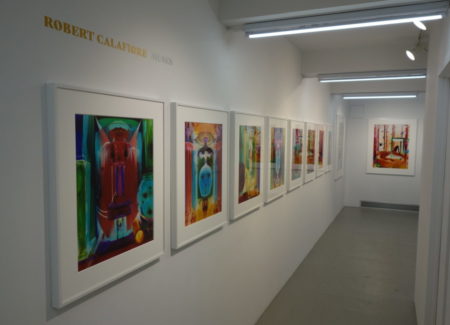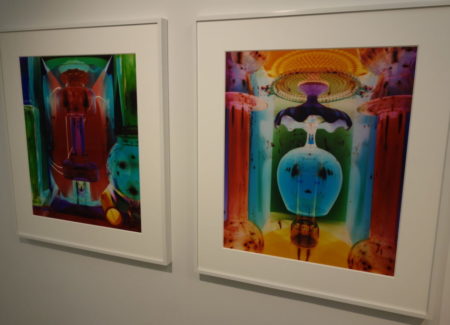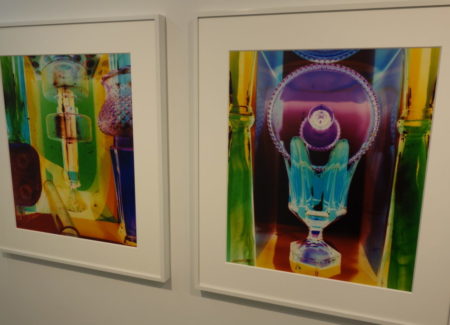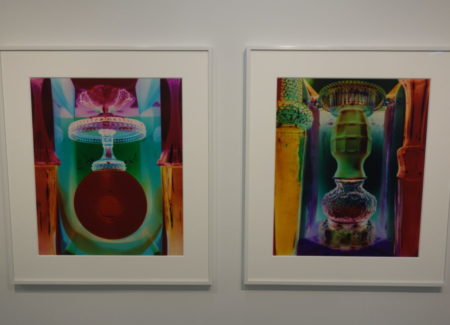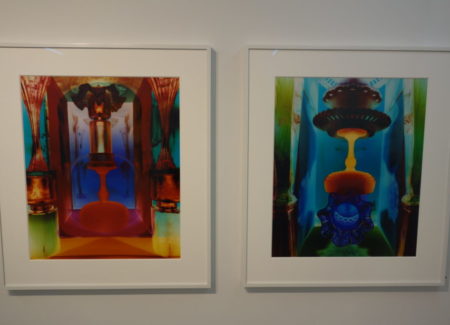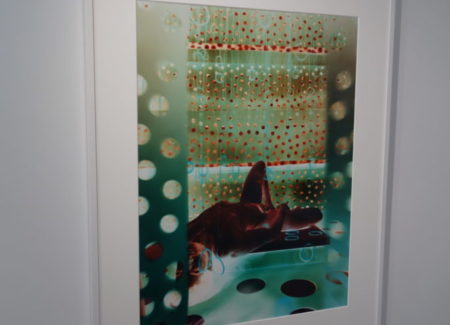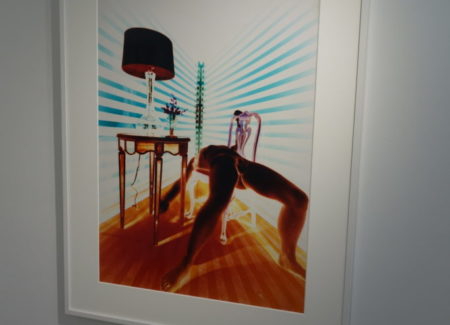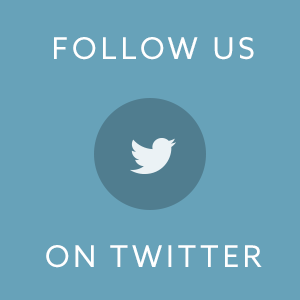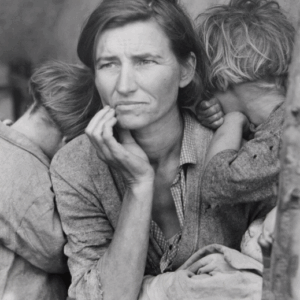JTF (just the facts): A total of 12 color photographic works (11 single images and 1 diptych), framed in white and unmatted, and hung against white walls in the back gallery space. All of the works are pinhole camera chromogenic prints, made either in 2008-2011 or in 2017. The prints are sized either 24×20 or 40×30 inches (the diptych consists of two 40×30 prints), and all of the works are unique. (Installation shots below.)
Comments/Context: Almost from the very moment that the medium was invented, photographers have been fascinated by the idea of making pictures of glassware. Given the way light passes through transparent glass and reflects, refracts, and flares across facets of crystal and curved surfaces, still lifes of glassware have been an enduringly popular subject, going all the way back to William Henry Fox Talbot’s “Articles of Glass” arrangement circa 1844. Since that time, we have repeatedly seen in-depth studies of single glasses (like Josef Sudek’s windowsill arrangements) and foreground glassware used to distort background objects/sitters (like several of Irving Penn’s see through compositions), and even today, glass almost never seems to disappoint in its willingness to be a malleable partner for a risk-taking photographer.
Robert Calafiore’s recent photographs of glass come at the subject from several new angles. To start with, the glass in Calafiore’s pictures isn’t just a jumble of oddball glassware picked up at tag sales for primary use in still life photographs. The glass objects in his images, from the large vases and vessels of various kinds to the more onate candy dishes, goblets, candlesticks and serving pieces were carefully collected by his Italian immigrant parents. So when he is arranging these items, memory, tradition, and nostalgia are thoroughly embedded in the process, making the resulting compositions both formal exercises and investigations of family and heritage.
His compositions are densely layered and centrally arranged, with matching items placed in flanking positions on both sides of more eye-catching pieces. Calafiore is undeniably adept at balancing these objects, as stacks of glassware perch in precarious towers, with many pieces turned around or flipped on their sides to enable better pattern matching or stability. His squared-off vange point creates a sense of depth and perspective moving in from the sides, almost as though we are travelling down a hallways of glass toward a treasure at the end.
Calafiore uses a large pinhole camera, whose long exposures (some are more than an hour long) and trial-and-error techniques introduce plenty of uncertainty into his process. The camera obscura reverses the tonalities of the image, creating negative exposures where light and dark are reversed. And in the case of glass as a subject, this inversion is particularly rich in its visual possibilities: dark areas and shadows tend to glow when reversed, and flares and highlights that normally dance across the surface of the glass appear as black spots.
All of this might have been meticulously dull had it not been for Calafiore’s electric use of color in these works. These pictures blast off the wall with candy-colored effervescence, each one a startling clash of hues from across the color wheel. By playing with saturation and translucency, Calafiore can effectively tune how the colors behave across each object, and it’s clear that he has encouraged them to adopt their brightest and most eye-catching properties. If Vera Lutter’s pinhole cityscapes have an otherworldly quiet to them, Calafiore’s arrangements are just the opposite – they jangle with ethereal energy, even when the inversions turn moody.
Tucked in the back, behind the array of glass still lifes in the narrow hallway, are a series of earlier male nudes. Using the same vibrant color pinhole approach, Calafiore has posed languid bodies (it’s a long exposure after all, so laying is likely easier than any other pose) in a series of constructed rooms, each one surrounded by a symphony of patterns. Perforated holes decorate one setting, plastic flowers create trees from vertical poles in another, while light bulbs dangle in bunches among leafy plants in a third. The result is a set of images that marry classical formality and over-the-top decoration in ways that are almost musical in their tone-reversed fluidity, where shadows turn into bright flares.
It’s taken several iterations of glass arrangements for Calafiore to slowly perfect his aesthetic formula, and these recent works are certainly the most richly layered and complex he’s made. Over time, he’s moved beyond singular (and perhaps formally obvious) objects toward more uncertain combinations and agglomerations, and it is these unlikely clusters and daredevil interactions that give these new images their spark.
Collector’s POV: The single prints in this show are priced at $3000 or $5000 based on size, with the diptych at $8500. Calafiore’s work has little secondary market history, so gallery likely retail remains the best option for those collectors interested in following up.
